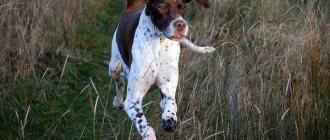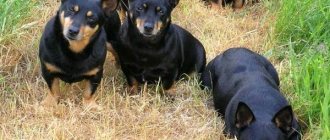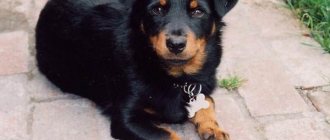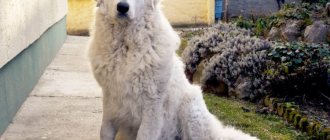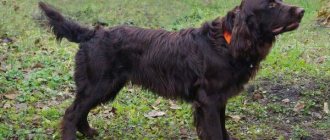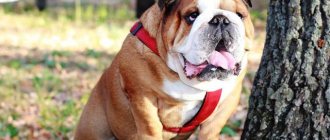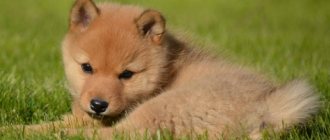Main characteristics
| Breed parameters | |
| Country of origin: | Great Britain |
| Weight of the breed: | males: 2.5-3.5 kg, females: 2.5-3.5 kg |
| Height at withers: | male: 25-31 cm, females: 25-31 cm |
| Temperament: | moderate |
| Wool: | short |
| Role in human life: | companion |
They are ideal companions, loyal and devoted friends. They get along well with children and get along with other pets, however, they require attention, love and care.
Origin story
The basis for the creation of the English Toy Terrier was the larger representative of the terrier - the Manchester. These animals quickly gained popularity and were the favorites of many noblemen of the Victorian era. Despite their very modest size, they performed well in hunting foxes and other burrowing animals, and also participated in rat fights. The dog was locked in a small pen along with a certain number of huge rats and it was supposed to quickly kill everyone.
Somewhat later, this entertainment was banned and they became simply rat catchers, which was very helpful during the plague epidemic. Over time, the first kennel club was organized in Britain, which specialized in organizing dog shows.
Previously, the breed was called the Miniature Black and Tan Terrier; they appeared in their current title only in the 60s. For many years, English Toy Terriers and Manchester Terriers were confused and even considered the same breed. And this is not surprising, because the former descended from the latter, and over time, the blood of the British began to be added to Manchester.
Treats for training and rewarding dogs
It is necessary to use edible treats in the first few months of training, while the puppy is just beginning to undergo training. Then, instead of giving treats, praise is expressed verbally. However, you should not completely exclude treats.
Note! The surprises that a dog receives during training should be special, which he does not get in ordinary life.
Also, do not over-encourage your dog. In this case, the animal will lose interest in training or simply overeat the treats and will not want to obey the person.
Treats and rewards help build rapport with your dog and get you used to exercise.
a brief description of
Today, English Toy Terrier dogs are on the verge of extinction. If the population issue is not resolved in the near future, humanity may be left without a wonderful companion.
These animals have a miniature build and a rather serious character. They are excellent companions who are always close to a person and follow on his heels. Toys become very attached to their owner and cannot imagine life without him. They are wary of strangers and loudly announce their approach. Dogs are very energetic, active, love care and require attention. Dogs practically do not shed and do not require complex care. This pet will be an ideal pet for the whole family.
Why is training needed?
To understand how to train a toy terrier at home, you need to understand the dog’s behavioral characteristics. The breed has a gentle and friendly character, but lack of education can give rise to aggression and anger. Training allows you to instill in your pet a sense of self-control, calmness and submission.
These dogs are very energetic, so you should decide in advance whether you should get a toy terrier.
Important! Before you start learning, you need to be patient. Any breed of dog requires regular lessons and a serious approach from the owner.
Breed standard
The English Toy Terrier is a smooth-haired dog characterized by its short stature, graceful build, elongated face, thin paws, large ears and beady eyes. The clarity of his movements indicates his breed. Compact, with well-developed muscles and strong bones. Height at withers up to 31 cm, weight approximately 3 kg.
- The head is elongated, in the form of a modified wedge. The skull is narrow, flat, and there is a small groove in the forehead area. The cheekbones are flat, there is a slight transition from the nose to the forehead, the length of the muzzle is equal to the length of the head. The nose mirror is voluminous, clearly visible, and the color is black.
- The ears are large, narrow, pointed at the ends, set high and close to the head. The direction is up and forward. Previously they were docked, but today it is prohibited.
- The eyes resemble black beads, have a characteristic shine, are set close to each other, the outer corner is raised up. The eyelids are dense, fit well to the skull, and have a black edging. The expression of the eyes is intelligent and alert. Large, excessively bulging eyes or, conversely, too small eyes are unacceptable.
- The neck is slightly arched, graceful, gradually widening towards the withers, thin at the base of the head.
- The withers are well defined and muscular.
- The back is straight, muscular, and short. The groin area is wide.
- The croup is rounded and somewhat sloping.
- The chest is narrow, the ribs are flattened, the stomach is retracted.
- The tail is of medium length, mobile, set low, wide at the base and tapering towards the end.
- The limbs are straight, the front elbow joints are tightly pressed to the body, directed strictly back. The hind limbs are muscular, the knee joints are well defined. The paw pads are small, with neat toes.
- The claws are pronounced and black. Movement is free, with good rear push.
- The coat is very short, shiny, and somewhat harsh to the touch. Acceptable color is black with bright tan.
Character and temperament
The English Toy, unlike many terriers, has a balanced character and a stable psyche. Nervous tremors are extremely rare in them, which is essentially a disadvantage of the breed.
Toys love to be the center of attention, they are a little selfish and believe that the whole world should revolve around them. They often have a “Napoleon complex”. The dog is confident in its superiority and tries to convince everyone at home of it.
These pets enjoy spending time with their family. They love children and play well with them. Very young children may be a little wary, as they are careless in their movements and can unknowingly cause pain. Therefore, it is very important to explain to your children how to behave with living beings, especially if they are small.
Although toys are excellent companions, they should not be classified as useless decorative dogs. The hunting instinct is in their blood. Sometimes echoes of the past make themselves felt and the dog cannot resist a “scandal” with larger dogs.
A brave and courageous dog needs early socialization. If you do not pay due attention to this, you can end up with an unpredictable and uncontrollable pet that will bark for days on end and attack everything that moves.
An English Toy can be very jealous; you need to fight this character trait from childhood. It is best if the puppy grows up in a family that has other pets.
Otherwise, these are loving animals, ready to give joy and love to people.
Where to start education
Training Alabai at home for a puppy and an adult
Training and education of a toy terrier should begin with teaching simple commands. Dogs of this breed are able to master them in 2-3 months of regular training. Puppies up to one year old need to be trained through play. First you need to give a command. If the dog does not understand what is required of it the first time, the owner must repeat it or show it again.
For each successful completion of a task, you need to reward the dog
For your information! You should not give up if the training process does not produce results. Each pet is individual, so the training time may vary. It is necessary to continue studying further and be persistent.
How to successfully train a toy terrier to a litter tray or diaper
Since the breed is very small and sensitive to cold and rain, a toilet for it is often built at home. A tray or diaper can serve as it. Many owners are interested in the question of how to stop a toy terrier from crapping at home. To do this, you need to follow several rules:
- You can cover the entire room with diapers or absorbent paper. Remove one every day until a couple remain. It is in these places that the puppy should defecate. The advantage of this method is that the pet gradually gets used to the toilet without stress. Training usually takes 2 to 4 weeks;
- The following method is suitable for those who want to train their dog to use the tray. Owners must carefully monitor the dog. When the puppy begins to sniff the area and sit down, he must be quickly taken to the tray. When the dog has emptied into the tray, it must be praised and given a treat. This method requires attentiveness on the part of the owner and patience.
It should be remembered that puppies usually walk small after sleep, and large after eating. Therefore, it is necessary to take the dog to the tray when it wakes up or eats a heavy meal.
Important! You should not force your toy terrier into a litter box and keep it there for a long time.
Accustoming to hygiene procedures
Raising a toy terrier also includes teaching hygiene. From an early age, the dog must be patient with ear cleaning, nail trimming, bathing, and grooming. Regular procedures will become the dog’s habit, so the animal will react to them much calmer.
How to wean yourself from bad habits
How to stop a toy terrier from biting is a question that worries many owners. Often this habit develops during games with the owner. Having played too much, the dog begins to bark and bite the person’s hands or feet. From an educational point of view, this type of dog behavior is unacceptable and should be stopped.
To let your pet know that the person is uncomfortable, you need to scream a little and show that the dog hurt you. The dog will understand that it did something wrong and can’t do it again. If the animal continues to bite, the owner should get up and leave the room. Thus, the person points out to the pet that the dog is behaving incorrectly.
Another bad habit of many dogs is chewing furniture. In this case, you need to hide all valuables away and buy special toys for the puppy.
How and what to play with a toy terrier
Reaction to the combination “nickname + team”
After the puppy appears in the house, it must be taught its name. Whenever you interact with a dog, you must say his name with a special intonation. The first training to remember a nickname should take place in a calm environment. It is best if at this moment only the puppy and the owner are in the house or on the street. Otherwise, the baby may get distracted. While the pet is getting used to the name, the nickname cannot be changed or distorted.
Note! One form is selected and pronounced until the dog begins to calmly respond to it.
Barking control
Learning to control your pet's barking is an important and necessary skill. A puppy should not bark without a reason, so you need to teach him to use his voice in the right situations. If a dog barks just like that, then the owner should ignore him. You can learn the command “quiet” and say it when the puppy simply starts barking.
The sooner bark control is mastered, the easier it will be to deal with an adult dog in the future.
Education and training
Animals are endowed with good mental abilities, however, they can be excessively stubborn. It is better to start training after six months; before six months it will be useless. To achieve a good result, the owner will have to be patient. If you cannot cope with your pet, then it is best to enlist the help of an experienced dog handler.
A specialist will help you correctly create a training schedule, correctly distribute lessons and sequence of commands. In the process of training, in no case should you offend the dog or raise a hand against him. Training must be built on trust.
How to teach basic commands
Every owner should know how to teach a toy terrier commands. Basic rules will help make the dog more restrained and obedient, which is very important for communicating with society.
Commands "fu!" and "you can't"
Beagle training: how to train at home
These two commands are considered the most common and indicate a ban on something. These words must be pronounced loudly and clearly so that the hyperactive toy terrier pays attention. If the dog does not react, you need to put it in front of you and repeat the command while looking into the animal’s eyes. When the dog begins to understand the command, you should praise it with a treat.
At first, it will take a lot of patience to accustom the dog, so the owner must suppress aggression and handle the pet calmly.
Note! Toy terriers are very small and fragile dogs, so aggression towards them can make the animal depressed or scared.
The "sit" command
This command is also suitable for new dog owners and first training lessons. The training goes like this:
- The owner holds the dog's favorite treat in his hand.
- The hand with the treat should be held at the level of the baby’s head, and with the other hand you should apply slight pressure on the lower back. In this case, it is necessary to repeat the command “sit”.
- When the dog sits down, give the pet a treat.
Dogs remember this rule in just a few lessons. In the future, the owner needs to train the pet on how long it can stay in a sitting position.
Commands “place”, “nearby”
It is necessary to show the puppy his bed and say “place”. During pronunciation, you need to pick up the dog and take it in the indicated direction. You can train the skill by standing near your pet’s bed and calling the dog by name, indicating the command “place”. If the animal obeys, it is rewarded.
While walking, you need to repeat the “near” rule and slightly pull the leash towards you so that the puppy is near the owner’s leg. This is done every time until the pet masters the command.
The “near” command is best practiced outdoors.
Nutrition
A puppy's diet is different from that of an adult dog. The number of feedings also differs. An adult should receive food twice a day, a puppy - 3-4, depending on age.
The animal's daily diet must contain lean meat, meat and bone components, cereals, vegetables and fruits, as well as additional vitamins and minerals. Puppies can be given cottage cheese, milk, and fermented milk products.
What not to give:
- Fatty pork, lamb.
- Bakery products.
- Sweets and chocolate.
- Tubular bones.
- I'm eating from the table.
Super-premium food for small breeds can be a substitute for natural food.
How to choose the right puppy?
Since the breed is quite rare, buying such a pet is not as easy as we would like. However, if you set yourself a goal, you can find quite decent nurseries. You will have to choose a foreign friend based on a photo and rely only on the information provided. However, this is not a Staffordshire Terrier, whose psyche must be checked, so there is not much chance of getting an unbalanced animal.
To avoid getting a “pig in a poke,” it is best to find a nursery in your country and personally visit the breeder. Preliminary acquaintance with the future family member will allow you to make the right choice.
At the time of sale, a purebred puppy must have a full package of documents: a veterinary passport with vaccination marks, a document of origin, a pedigree.
